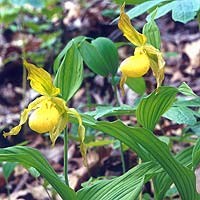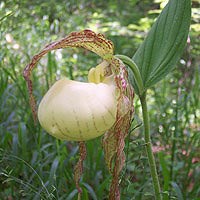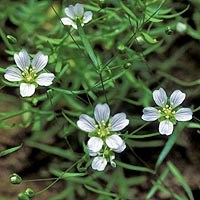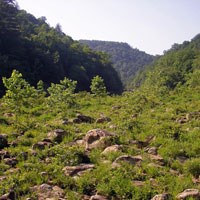
C. Summers In contrast to the upland forest zone, the gorge forest zone is often moist with deeper, richer soils. Major forest types in this zone include rich mixed-deciduous forest, hemlock ravine forest, and floodplain forest. Two of the most unique plant communities within this zone are the river cobblebar community and sandstone rockhouse community. Gorge Forests 
National Park Service This forest type, also called a mixed-mesophytic forest, occurs in rich, moist, well-drained soils on lower slopes, north- to east-facing slopes, and other sheltered locations. Major tree species include American beech, sugar maple, yellow-poplar, northern red oak, basswood, cucumber magnolia, yellow buckeye, shagbark hickory, and hemlock. The midstory and shrub layer contain big-leaf magnolia, umbrella magnolia, mountain stewartia, dogwood, spicebush, sweet pepperbush, wild hydrangea, pawpaw, rhododendron, and maple-leaf viburnum. The herbaceous layer is particularly diverse, with the best examples occurring on lower slopes. These are the best sites for observing spring favorites, such as trilliums, bellworts, black cohosh, blue cohosh, Solomon’s seal, trout lily, bloodroot, wild ginger, maidenhair fern, Jack-in-the-pulpit, phlox, spring beauty, and violets. RavineForest Hemlock and white pine are the major presence along the steep ravines of steep tributary creeks that flow into larger branches or the main river. Often the bank of the creek is further shaded by a dense tangle of rhododendron that excludes the growth of many other shrub or herbaceous plants. This shade provided by the evergreen canopy of rhododendron, hemlock, and white pine is important in maintaining lower stream temperatures which is important for certain aquatic life. This forest type is currently at risk in many parts of the southern Appalachians from a non-native insect, hemlock wooly adelgid. Although not yet present at Big South Fork, there is fear that this destructive insect will soon arrive. 
National Park Sevice FloodplainForest This forest type occurs along the main river and large tributaries in deep silt and sediment deposited from frequent floods. River birch, yellow-poplar, sweetgum, sycamore, green ash, black walnut, white walnut, elm, and boxelder maple are among the most common tree species. The understory typically includes ironwood, spicebush, sweetshrub, leatherwood, poison ivy, and cane. This is mong the most susceptible of forests to invasion by non-native plants. Major portions of the floodplain are infested with Japanese spiraea and Nepalese browntop. Patches of tree-of-heaven, multiflora rose, garlic mustard, and Japanese knotweed are also present, particularly where homesteads or small communities previously occurred along the river. Efforts are currently underway to remove these exotic plants in a manner that does not damage the sensitive, native floodplain plant community. Unique Gorge Communities 
National Park Service Sandstone Rockhouses On a hot summer day, there is perhaps no cooler place to be outdoors in Big South Fork than inside one of hundreds of sandstone rockhouses. Rockhouses are shady, humid, cave-like features that occur throughout the park along the bottom of cliffs. Some rockhouses have floors composed of sand that has eroded from the cliff face and rockhouse ceiling over thousands of years. When exploring rockhouses, watch where you walk! In the protected environment of some rockshelters, growing in the sand, are a number of rare species, such as Cumberland sandwort and Lucy Braun’s white snakeroot. Only a few other plant species regularly grow in these habitats.

National Park Service River Cobblebars One of the park’s most botanically interesting communities is the river cobble bar that occurs along the Big South Fork and Clear Fork. These habitats are strongly affected by winter floods and big summer storms. As fast moving water carries logs and other debris across the cobblebars, the substrate is scoured and many of the wood plants growing on the bars are knocked over or broken. As a result, shrubs, grasses, and forbs are the dominant species. The plants that can survive the cycle of floods must also be able to survive extreme heat and drought during low-water period of summer. Sycamore, blackgum, river birch, persimmon, and eastern redcedar are the most common trees that are able to survive these harsh conditions. Alder, willow, buttonbush, silky dogwood, ninebark, arrow wood and azaleas grow in a shrubby transition between the floodplain forest and the cobblebar. The cobblebar’s center is the hottest and driest portion and the species that occur here are some of the same plants that grow in dry upland barrens and exposed sandstone cliff tops. Many rare plants are known to occur on Big South Fork cobblebars. |
Last updated: April 14, 2015
